|
|
Prince Palatine

|
|
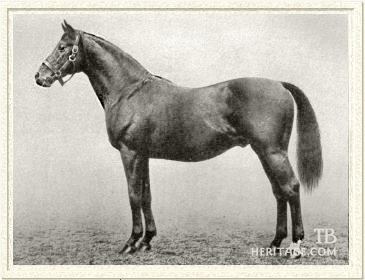 |
|
|
Prince Palatine was an exceptional racehorse in Great Britain during the years just before World War I. He won nearly every important event on the racing calendar--the St. Leger, the Coronation Cup, the Doncaster Cup, the Jockey Club Cup, the Eclipse Stakes, and the Ascot Gold Cup, twice.
His breeder, Col. William Hall Walker, later Lord Wavertree, maintained his stud at Tully, Co. Kildare, in Ireland, and that is where Prince Palatine was foaled and raised. Walker bred Minoru, a colt he leased to King Edward VII, and which won the Two Thousand Guineas and the Derby for the monarch. Other Tully-bred horses included classic winners Cherry Lass, Witch Elm, and Night Hawk, as well as major winners Royal Realm, Black Arrow, and White Eagle. Walker also bred the winless Blanche, destined to become the dam of Blandford, arguably the best sire bred in Great Britain in the 20th century.
In 1916, during the height of World War I, Col. Walker gifted all of his Thoroughbred horses to the British Government, which, as part of the arrangement, purchased Tully and the Walker-owned training stables in England, laying the foundation for Britian's National Stud. His remarkable gift to his country during a time of war was gratefully recognized, as he was created Lord Wavertree.
|
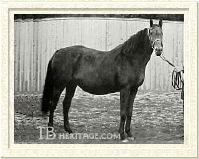
His dam, Lady Lightfoot
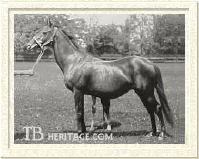
His second dam, Glare
| |
Prince Palatine's Female Family
Prince Palatine was from the last crop of the King's Derby hero, Persimmon. His dam, Lady Lightfoot, was by Triple Crown champion Isinglass, and was a half sister to St. Frusquin's daughter, Flair, a victress in the One Thousand Guineas.
Glare, the second dam of Prince Palatine, was bred by Sir Daniel Cooper and sold as a yearling to Col. Walker. As a racer, her best win came in the Fern Hill Stakes as a juvenile. Col. Walker prized her as a broodmare prospect, and she gave him tremendous service, with Flair and her stakes-winning sister, Lesbia. Lady Lightfoot, however, was a disappointing filly on the track. She won some minor events and was also tried over hurdles, but with limited success.
Col. Walker considered Lady Lightfoot's handsome bay colt by Persimmon the finest horse he had ever bred, and he fully intended to keep him to run in his own colors. In 1909 he sold all his yearling colts, intending to keep Prince Palatine out of the sale. But the agent for Col. Walker accidentally included the colt in the sale, and Prince Palatine went to Sir. Thomas Pilkington for 2,000 guineas. At first, Col. Walker thought about repudiating the sale, but in the interest of good sportsmanship, he did not, even though the colt had been sold for a fraction of the 10,000 guineas value Col. Walker placed on him.
|
| Paraffin (1870) by Blair Athol - Paradigm) Family 1 - l |
Footlight
(1876)
(by Cremorne)
Unraced |
Illuminata
(1877)
(by Rosicrucian)
Dam of Ladas, Chelandry, Gas, Phosphine, Ebba, Vauxhall |
Almondell
(1879)
(by Scottish Chief)
Ancestress Grand Marnier, Foxhunter, Light Brocade |
Paraguay
(1887)
(by Foxhall)
|
Allemeuse
(1890)
(by St. Simon)
Dam of Ladasine |
| Footlight's Daughters Family 1 - m |
Glare
(1891)
(by Aryshire)
Fernhill St and 3 others at 2;
sp Newmarket St |
Lightfoot
(1887)
(by Muncaster)
Champion Nursery at 2; sp at 3
Dam of Royal Lancer |
Float
(1892)
(by Sheen)
Won once at 2; unplaced at 3
Dam of Flotsam |
Serpentine
(1896)
(by St. Serf)
Woodcote Stakes
Ancestress
Lauco, Panorama |
Silver Thread
(1898)
(by Aryshire)
Unraced
Ancestress
Bettina |
| Glare's Daughters |
Lady Lightfoot
(1900)
(by Isinglass)
Leigh Park Plate and others at 2; Pheasant HC and others at 3 |
Ladyland
(1898)
(by Kendal)
Unraced
Ancestress Lentulus, Lampos, Laland |
Flair
(1903)
(by St. Frusquin)
Top 2 yo;
1000 Guineas
Ancestress Phar Lap |
Lesbia
(1905)
(by St. Frusquin)
Unbeaten at 2;
Coronation St., July S. |
Menda
(1907)
(by Gallinule)
Unplaced
Dam of Rossendale, Cressington |
|
Prince Palatine as a Racehorse
Pilkington was a manufacturer from Lancashire who had raced horses for several years. Prince Palatine was the best horse he ever owned. The colt was sent to the stable yards of Whatcombe, in Berkshire, to be trained by Henry Beardsley. The son of Persimmon was backward in his early days, and, as a juvenile, showed none of the precociousness his sire had at that age. Prince Palatine also had very tender feet, which plagued him throughout his life. He made six starts at age two, and won three times, his most important win coming in the Imperial Produce Plate at Kempton Park. He was twice unplaced, including a fifth place finish in the important Dewhurst Plate.
Prince Palatine was still very backward the next spring. Col. Walker had not nominated him to the Two Thousand Guineas, and the colt was nowhere near ready to run in the Derby in early June. Consequently, he did not come out until Ascot, where he ran second in the Biennial Stakes. A second in the Midsummer Stakes at Newmarket followed, before Prince Palatine broke through and captured the Gordon Stakes at Goodwood at a mile and a half. This set the colt up nicely for the St. Leger at Doncaster in the fall. In that race, Prince Palatine showed he was developing into something special. He won by six lengths in a canter. This victory made him the fifth, and final, classic winner sired by Persimmon.
Prince Palatine's last race as a three-year-old, the Kingsclere Stakes at Newbury, also marked his first against Stedfast, a fine Chaucer colt, bred and raced by Lord Derby. Stedfast had been beaten by Sunstar in both the Two Thousand Guineas and the Derby, but had then scored seven straight victories, including the Prince of Wales Stakes and the St. James Palace Stakes. For the Kingsclere, Stedfast was assigned seven pounds less than his classic-winning rival, Prince Palatine. The two colts staged a great competition, and at the end, Stedfast came away the victor by half a length.
Stedfast and Prince Palatine, now age 4, met again the next spring at Epsom, in the Coronation Cup. Stedfast was sharper that day, and beat Prince Palatine for a second time.
There was no Stedfast in his next start, the Ascot Gold Cup, but there was a high class French mare named Basse Pointe. She was no match -- Prince Palatine made a shambles of the race. He easily won the two and a half mile event by a commanding five lengths, with Basse Pointe putting up a courageous effort to place second. Prince Palatine then reeled off three consecutive victories. He won the Eclipse Stakes by a head over Stedfast, both colts carrying equal weight; Derby winning filly Tagalie finished down the course. He then won the Doncaster Cup in a canter by ten lengths over a solitary opponent, and the Jockey Club Stakes, again with Stedfast second best by half a length, even though Lord Derby's colt was carrying thirteen pounds less. Prince Palatine was then beaten soundly by a moderate animal named Aleppo in the Jockey Club Cup in his last outing of the season.
The Prince was back in form the next spring. He easily captured the Coronation Cup by three lengths, and then prepared to defend his title in the Ascot Gold Cup. In that race, Prince Palatine would be opposed by a fine field, including Stedfast and August Belmont's colt, Tracery. The latter was a high class colt. He had finished third in the Derby in his maiden outing, and then gone on to capture the St. James Palace Stakes and the Sussex Stakes prior to running in the Gold Cup. His form was such that many believed he could upset the favorite.
Tracery was going like an easy winner, as Prince Palatine had fallen twenty lengths back. All of a sudden, a man leapt onto the track and brought Tracery down. The man, a protester for the suffragette movement, was seriously injured. Prince Palatine was kept out of trouble by his rider, W. Saxby, and proceeded to pass the fracas and win the Gold Cup for the second time. Tracery, uninjured by the fall, lost nothing in defeat, as many thought he would have won the race had it not been for the incident. To cement that view, Tracery went on to capture the Eclipse Stakes, the St. Leger and the Champion Stakes later that autumn.
Prince Palatine had attracted the attention of breeder S.B. Joel , and a deal was struck between him and Pilkington, with the assistance of Somerville Tattersall, to sell the son of Persimmon to Joel for £45,000, at the time the heaviest price ever paid for a Thoroughbred. The deal contained a clause that the price would be £5,000 less if the horse were to be defeated before the end of the season.
|
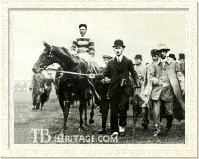
Prince Palatine After the Ascot Gold Cup | |
Prince Palatine did lose his next outing, which turned out to be his last, the Goodwood Cup. The Prince clearly was not the same horse he had been. He finished out of the money for the first time since his juvenile days, losing the race to Catmint. Utterly exhausted and his feet giving him severe pain, he was retired and sent to stand at Joel's Childwickbury Stud, St. Albans, Hertfordshire, at a fee of 400 guineas.
All told, Prince Palatine had won eleven races, ranging from the six furlongs of the Imperial Produce Plate to the two and a half miles of the Ascot Gold Cup. His earnings, the equivalent of $184,500.00, put him just behind Pretty Polly and ahead of his sire, Persimmon, and St. Frusquin on the list of the top dozen English money winners prior to 1931. |
Prince Palatine in the Stud
Prince Palatine was not a success at stud, proving to be a shy breeder. In all, throughout his stud career, he sired about fifty recorded foals. Joel sold him in 1918 to Duc Decazes for a reputed £18,000, and Prince Palatine was sent to France. In 1920, he was sold again, to Edward F. Simms, and sent to America to stand the remainder of his life at Xalapa Stud near Paris, Kentucky. |
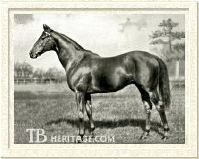
Rose Prince
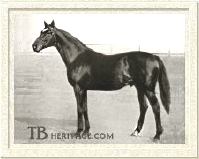
Donnacona
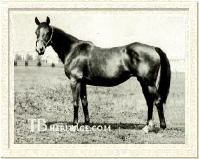
Afternoon
| |
While Prince Palatine has been described as a failure at stud, he nonetheless made some very important genetic contributions to the breed, both in Europe and in America, through one son and four daughters.
The son, ROSE PRINCE, established a strong male line that linked Prince Palatine to succeeding generations. Rose Prince was only a fair racer, his biggest win coming in the Cesarewitch Handicap in Britain by a head over the filly Teresina. Rose Prince, out of Eglantine, by Perth, was not a terrific stallion. His best offspring was a colt out of Indolence, by Gay Crusader, which raced under the name Prince Rose.
Prince Rose, bred in England, was sold for a pittance at the Newmarket December sale and sent to Belgium. There, he became an extraordinary racehorse. In Belgium, he won nearly a dozen stakes in his career, and cemented his international credentials with a third place finish in the Prix de l'Arc de Triomphe and a victory in the Prix du President de la Republique. He was beaten only once in seventeen lifetime starts. As a stallion, he sired three sons that were tremendously important: Princequillo, Prince Bio, and Prince Chevalier. These three stallions founded lines that led to such influential sires as Princequillo, Prince John, Round Table, Prince Taj, Sicambre, Charlottesville, and Pretendre.
Prince Palatine had four daughters which also proved highly influential over the next several decades, though none of these daughters made a mark on the racetrack. PRINCESS PALATINE, foaled from the good producer Frizette, was born in 1919. Mated to Man o' War, Princess Palatine foaled Valkyr, a stakes-placed filly and a fine producer for her owner, William Woodward. Valkyr produced champion mare Vagrancy to the cover of Sir Gallahad III and multiple stakes winning filly Hypnotic, by Hypnotist. Vagrancy went on to found a family rich in quality. Her own son, Black Tarquin, won the St. Leger for Woodward, and she also produced major winners Hyvania and Vulcania. Other descendants include Nascania, Natashka, Banja Luka, and Kentucky Derby champion Ferdinand.
|
Prince Palatine's daughter, AFTERNOON, foaled in 1917 from Matinee, by Broomstick, became renowned for her daughter, Flyatit, by Peter Pan. Flyatit gave birth in 1929 to a striking looking filly by Dis Donc that was given the name Top Flight. Top Flight became one of the most brilliant juveniles seen since the days of Man o' War. She was unbeaten at age two, racking up wins in the Pimlico Futurity, Futurity Stakes, Spinaway Stakes, and the Saratoga Special. At three, she added the Alabama Stakes and the Coaching Club American Oaks to her twelve victories in sixteen lifetime starts. Afternoon also produced a colt by Mad Hatter, named The Nut, who won the Lawrence Realization and placed in the Suburban Handicap, the Travers Stakes, and the Jockey Club Gold Cup.
BLUE GLASS, Prince Palatine's daughter from the Rock Sand mare Hour Glass, was owned by August Belmont and acquired by George Widener after Belmont's death. For Belmont, she produced stakes winners Blind Play, by Fair Play, and Broadside, by Man o' War. For Widener, she foaled Belmont Stakes winner Hurry Off. In 1935, at age eighteen, Blue Glass foaled a colt to the cover of the imported stallion, Sickle. The colt was Unbreakable, a good stakes winner in England, who was then returned to the states for stud duty. His most notable offspring was Preakness winner, Polynesian, sire of Native Dancer. Through Native Dancer, Prince Palatine's blood has been widely dispersed, as Native Dancer founded a male line through Raise a Native, his sons Alydar and Mr. Prospector, and their descendants that is one of the most powerful and fashionable in the breeding world today. Native Dancer was also the broodmare sire of Northern Dancer, widely acclaimed as one of the most successful stallions of this century.
Prince Palatine's daughter, LA SOUPE II, sired during his stay in France, became the second dam of the influential mare Boudoir II. From her descend such familiar horses as Flower Bowl, Bowl of Flowers, Gallant Bloom, Graustark, His Majesty, Your Host, Your Hostess, Gay Hostess, Majestic Prince, Crowned Prince, and Real Quiet.
Prince Palatine never produced anything that was remotely like himself as a runner, though his son, PRINCE GALAHAD did win the Dewhurst Stakes, and another son, DONNACONA, ran second to Man o' War in the Belmont Stakes. A daughter, BARBARA, won the Ashland Handicap. Prince Palatine was also the grandsire of an American classic winner, as his son, PRINCE PAL sired Mate, who defeated Twenty Grand in the 1931 Preakness Stakes.
Prince Palatine was not recognized as a stallion of importance until years after his death, when grandson Prince Rose and his descendants, and the descendants of Prince Palatine's daughters garnered attention. Because of them, there is some blood of Prince Palatine coursing through the veins of virtually every American classic winner of the last thirty years, as well as a good portion of Europe's classic winners. Quite an achievement for a stallion condemned as a failure during his lifetime.
Prince Palatine died during the evening of October 13, 1924, at the age of sixteen. A fire, reportedly caused by an electrical malfunction, set his barn on fire, and the stallion burned to death in his stall. He was buried at Xalapa in a tree-shaded area off one of the farm roads. A boulder, with his name etched upon it, was erected over the grave and can still be seen today.
--Elizabeth Martiniak
|
|
|
|

